Organizational Creativity: Barriers, Benefits, and Recommendations
VerifiedAdded on 2020/04/21
|10
|2493
|46
Report
AI Summary
This report provides a comprehensive analysis of organizational creativity and innovation within the business world. It emphasizes the significance of creativity for maintaining competitiveness, increasing productivity, and improving profit margins. The report explores the benefits of organizational creativity, such as enhanced teamwork, increased workplace engagement, improved employee retention, boosted staff morale, and enhanced problem-solving skills. However, the report identifies several barriers to establishing a creative culture, including adherence to strict rules, fear of failure, lack of time, executive stress, and resistance to change. The report recommends strategies to overcome these barriers, such as providing employees with freedom, resources, and time to implement innovative ideas, while also encouraging individuals to expand their knowledge and use their senses. The report concludes by highlighting the crucial role of leaders and mentors in fostering a creative work environment by promoting the importance of creativity and innovation, providing guidance, and encouraging employees to embrace innovative strategies.
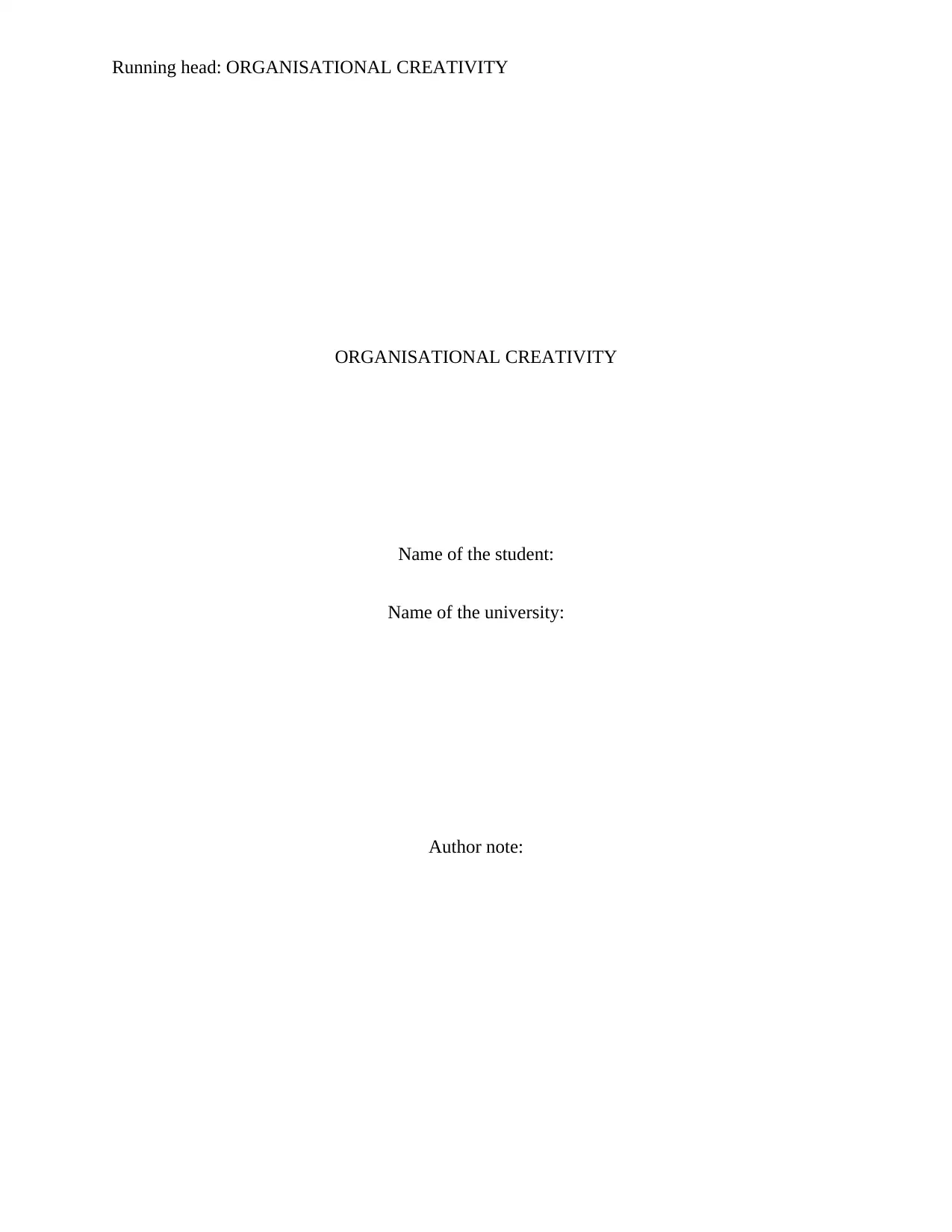
Running head: ORGANISATIONAL CREATIVITY
ORGANISATIONAL CREATIVITY
Name of the student:
Name of the university:
Author note:
ORGANISATIONAL CREATIVITY
Name of the student:
Name of the university:
Author note:
Paraphrase This Document
Need a fresh take? Get an instant paraphrase of this document with our AI Paraphraser
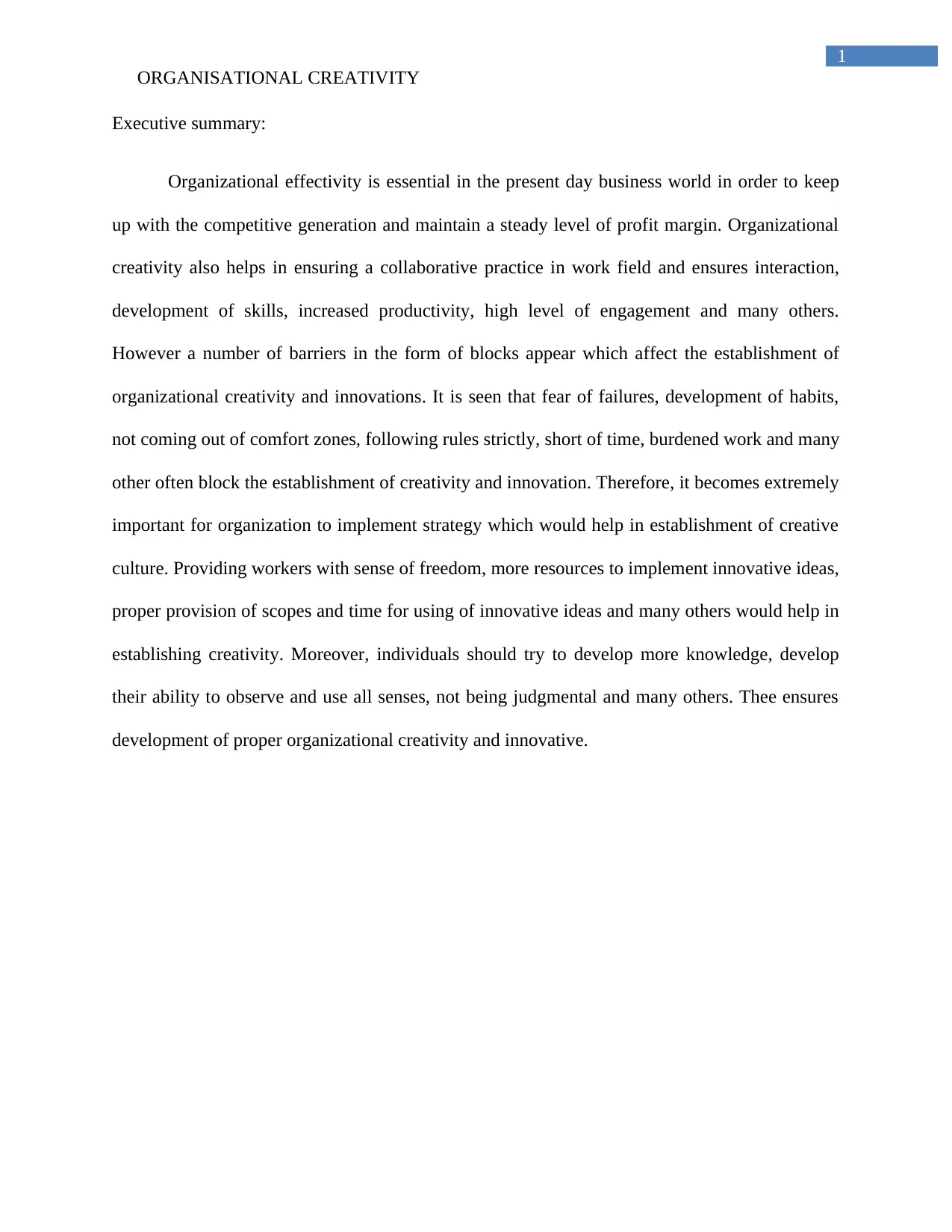
1
ORGANISATIONAL CREATIVITY
Executive summary:
Organizational effectivity is essential in the present day business world in order to keep
up with the competitive generation and maintain a steady level of profit margin. Organizational
creativity also helps in ensuring a collaborative practice in work field and ensures interaction,
development of skills, increased productivity, high level of engagement and many others.
However a number of barriers in the form of blocks appear which affect the establishment of
organizational creativity and innovations. It is seen that fear of failures, development of habits,
not coming out of comfort zones, following rules strictly, short of time, burdened work and many
other often block the establishment of creativity and innovation. Therefore, it becomes extremely
important for organization to implement strategy which would help in establishment of creative
culture. Providing workers with sense of freedom, more resources to implement innovative ideas,
proper provision of scopes and time for using of innovative ideas and many others would help in
establishing creativity. Moreover, individuals should try to develop more knowledge, develop
their ability to observe and use all senses, not being judgmental and many others. Thee ensures
development of proper organizational creativity and innovative.
ORGANISATIONAL CREATIVITY
Executive summary:
Organizational effectivity is essential in the present day business world in order to keep
up with the competitive generation and maintain a steady level of profit margin. Organizational
creativity also helps in ensuring a collaborative practice in work field and ensures interaction,
development of skills, increased productivity, high level of engagement and many others.
However a number of barriers in the form of blocks appear which affect the establishment of
organizational creativity and innovations. It is seen that fear of failures, development of habits,
not coming out of comfort zones, following rules strictly, short of time, burdened work and many
other often block the establishment of creativity and innovation. Therefore, it becomes extremely
important for organization to implement strategy which would help in establishment of creative
culture. Providing workers with sense of freedom, more resources to implement innovative ideas,
proper provision of scopes and time for using of innovative ideas and many others would help in
establishing creativity. Moreover, individuals should try to develop more knowledge, develop
their ability to observe and use all senses, not being judgmental and many others. Thee ensures
development of proper organizational creativity and innovative.
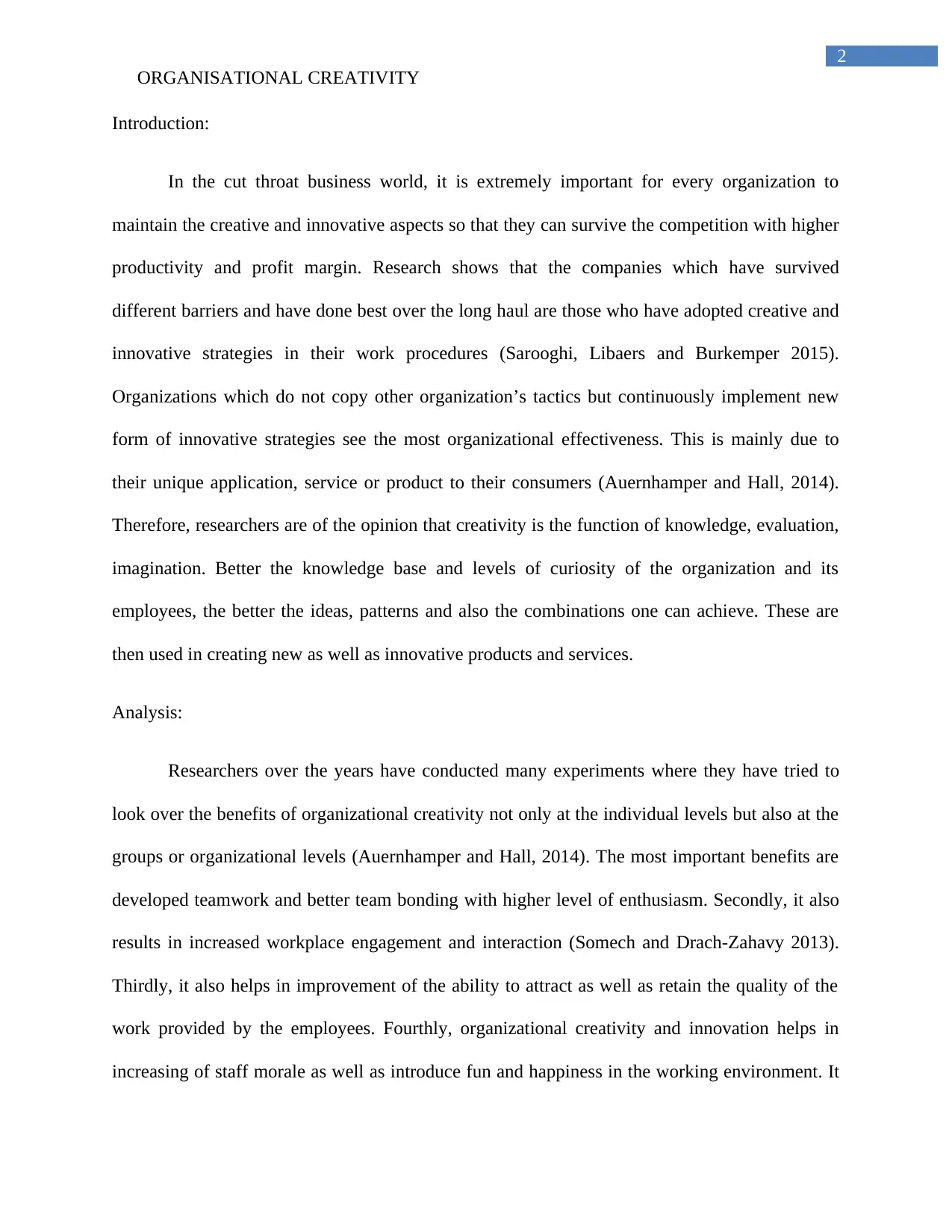
2
ORGANISATIONAL CREATIVITY
Introduction:
In the cut throat business world, it is extremely important for every organization to
maintain the creative and innovative aspects so that they can survive the competition with higher
productivity and profit margin. Research shows that the companies which have survived
different barriers and have done best over the long haul are those who have adopted creative and
innovative strategies in their work procedures (Sarooghi, Libaers and Burkemper 2015).
Organizations which do not copy other organization’s tactics but continuously implement new
form of innovative strategies see the most organizational effectiveness. This is mainly due to
their unique application, service or product to their consumers (Auernhamper and Hall, 2014).
Therefore, researchers are of the opinion that creativity is the function of knowledge, evaluation,
imagination. Better the knowledge base and levels of curiosity of the organization and its
employees, the better the ideas, patterns and also the combinations one can achieve. These are
then used in creating new as well as innovative products and services.
Analysis:
Researchers over the years have conducted many experiments where they have tried to
look over the benefits of organizational creativity not only at the individual levels but also at the
groups or organizational levels (Auernhamper and Hall, 2014). The most important benefits are
developed teamwork and better team bonding with higher level of enthusiasm. Secondly, it also
results in increased workplace engagement and interaction (Somech and Drach-Zahavy 2013).
Thirdly, it also helps in improvement of the ability to attract as well as retain the quality of the
work provided by the employees. Fourthly, organizational creativity and innovation helps in
increasing of staff morale as well as introduce fun and happiness in the working environment. It
ORGANISATIONAL CREATIVITY
Introduction:
In the cut throat business world, it is extremely important for every organization to
maintain the creative and innovative aspects so that they can survive the competition with higher
productivity and profit margin. Research shows that the companies which have survived
different barriers and have done best over the long haul are those who have adopted creative and
innovative strategies in their work procedures (Sarooghi, Libaers and Burkemper 2015).
Organizations which do not copy other organization’s tactics but continuously implement new
form of innovative strategies see the most organizational effectiveness. This is mainly due to
their unique application, service or product to their consumers (Auernhamper and Hall, 2014).
Therefore, researchers are of the opinion that creativity is the function of knowledge, evaluation,
imagination. Better the knowledge base and levels of curiosity of the organization and its
employees, the better the ideas, patterns and also the combinations one can achieve. These are
then used in creating new as well as innovative products and services.
Analysis:
Researchers over the years have conducted many experiments where they have tried to
look over the benefits of organizational creativity not only at the individual levels but also at the
groups or organizational levels (Auernhamper and Hall, 2014). The most important benefits are
developed teamwork and better team bonding with higher level of enthusiasm. Secondly, it also
results in increased workplace engagement and interaction (Somech and Drach-Zahavy 2013).
Thirdly, it also helps in improvement of the ability to attract as well as retain the quality of the
work provided by the employees. Fourthly, organizational creativity and innovation helps in
increasing of staff morale as well as introduce fun and happiness in the working environment. It
⊘ This is a preview!⊘
Do you want full access?
Subscribe today to unlock all pages.

Trusted by 1+ million students worldwide
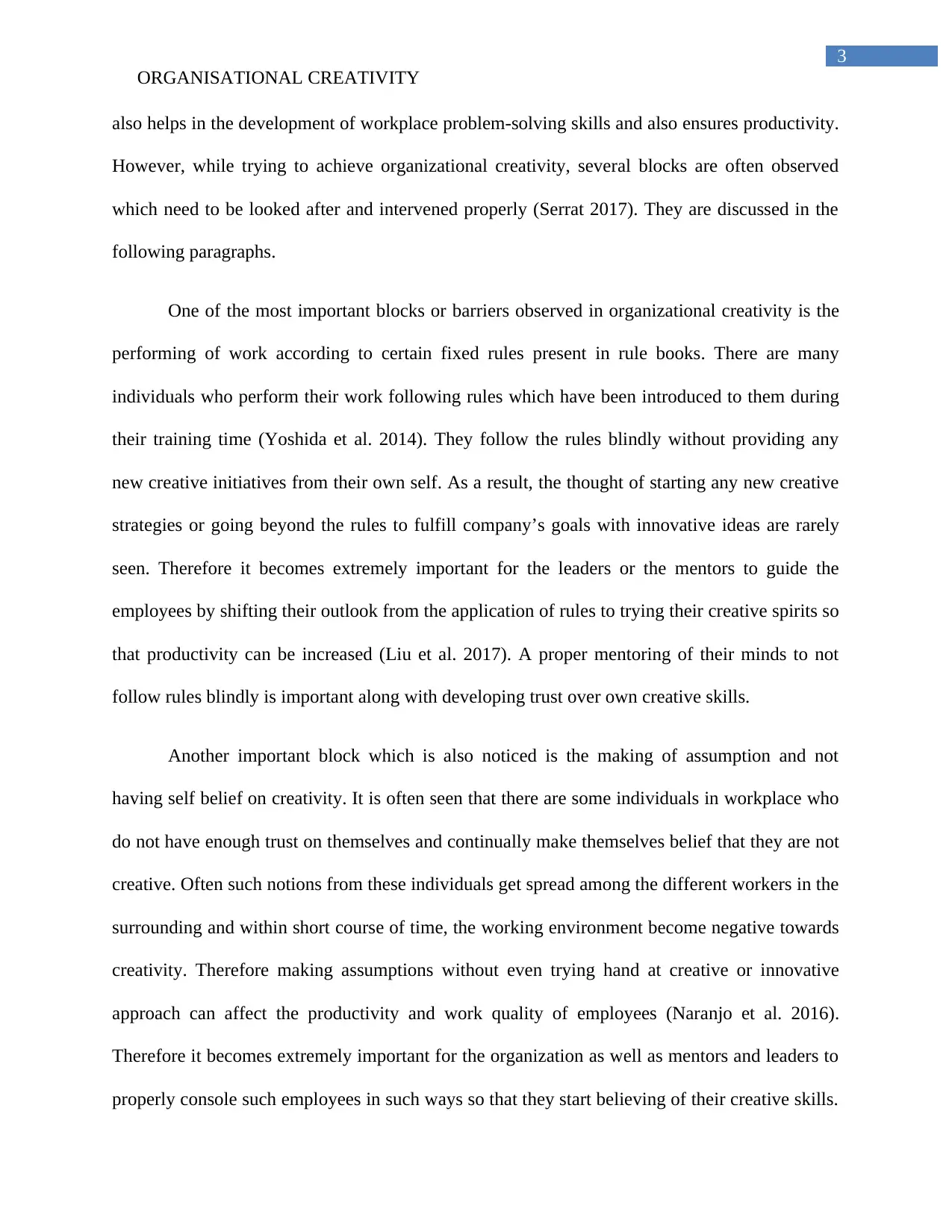
3
ORGANISATIONAL CREATIVITY
also helps in the development of workplace problem-solving skills and also ensures productivity.
However, while trying to achieve organizational creativity, several blocks are often observed
which need to be looked after and intervened properly (Serrat 2017). They are discussed in the
following paragraphs.
One of the most important blocks or barriers observed in organizational creativity is the
performing of work according to certain fixed rules present in rule books. There are many
individuals who perform their work following rules which have been introduced to them during
their training time (Yoshida et al. 2014). They follow the rules blindly without providing any
new creative initiatives from their own self. As a result, the thought of starting any new creative
strategies or going beyond the rules to fulfill company’s goals with innovative ideas are rarely
seen. Therefore it becomes extremely important for the leaders or the mentors to guide the
employees by shifting their outlook from the application of rules to trying their creative spirits so
that productivity can be increased (Liu et al. 2017). A proper mentoring of their minds to not
follow rules blindly is important along with developing trust over own creative skills.
Another important block which is also noticed is the making of assumption and not
having self belief on creativity. It is often seen that there are some individuals in workplace who
do not have enough trust on themselves and continually make themselves belief that they are not
creative. Often such notions from these individuals get spread among the different workers in the
surrounding and within short course of time, the working environment become negative towards
creativity. Therefore making assumptions without even trying hand at creative or innovative
approach can affect the productivity and work quality of employees (Naranjo et al. 2016).
Therefore it becomes extremely important for the organization as well as mentors and leaders to
properly console such employees in such ways so that they start believing of their creative skills.
ORGANISATIONAL CREATIVITY
also helps in the development of workplace problem-solving skills and also ensures productivity.
However, while trying to achieve organizational creativity, several blocks are often observed
which need to be looked after and intervened properly (Serrat 2017). They are discussed in the
following paragraphs.
One of the most important blocks or barriers observed in organizational creativity is the
performing of work according to certain fixed rules present in rule books. There are many
individuals who perform their work following rules which have been introduced to them during
their training time (Yoshida et al. 2014). They follow the rules blindly without providing any
new creative initiatives from their own self. As a result, the thought of starting any new creative
strategies or going beyond the rules to fulfill company’s goals with innovative ideas are rarely
seen. Therefore it becomes extremely important for the leaders or the mentors to guide the
employees by shifting their outlook from the application of rules to trying their creative spirits so
that productivity can be increased (Liu et al. 2017). A proper mentoring of their minds to not
follow rules blindly is important along with developing trust over own creative skills.
Another important block which is also noticed is the making of assumption and not
having self belief on creativity. It is often seen that there are some individuals in workplace who
do not have enough trust on themselves and continually make themselves belief that they are not
creative. Often such notions from these individuals get spread among the different workers in the
surrounding and within short course of time, the working environment become negative towards
creativity. Therefore making assumptions without even trying hand at creative or innovative
approach can affect the productivity and work quality of employees (Naranjo et al. 2016).
Therefore it becomes extremely important for the organization as well as mentors and leaders to
properly console such employees in such ways so that they start believing of their creative skills.
Paraphrase This Document
Need a fresh take? Get an instant paraphrase of this document with our AI Paraphraser
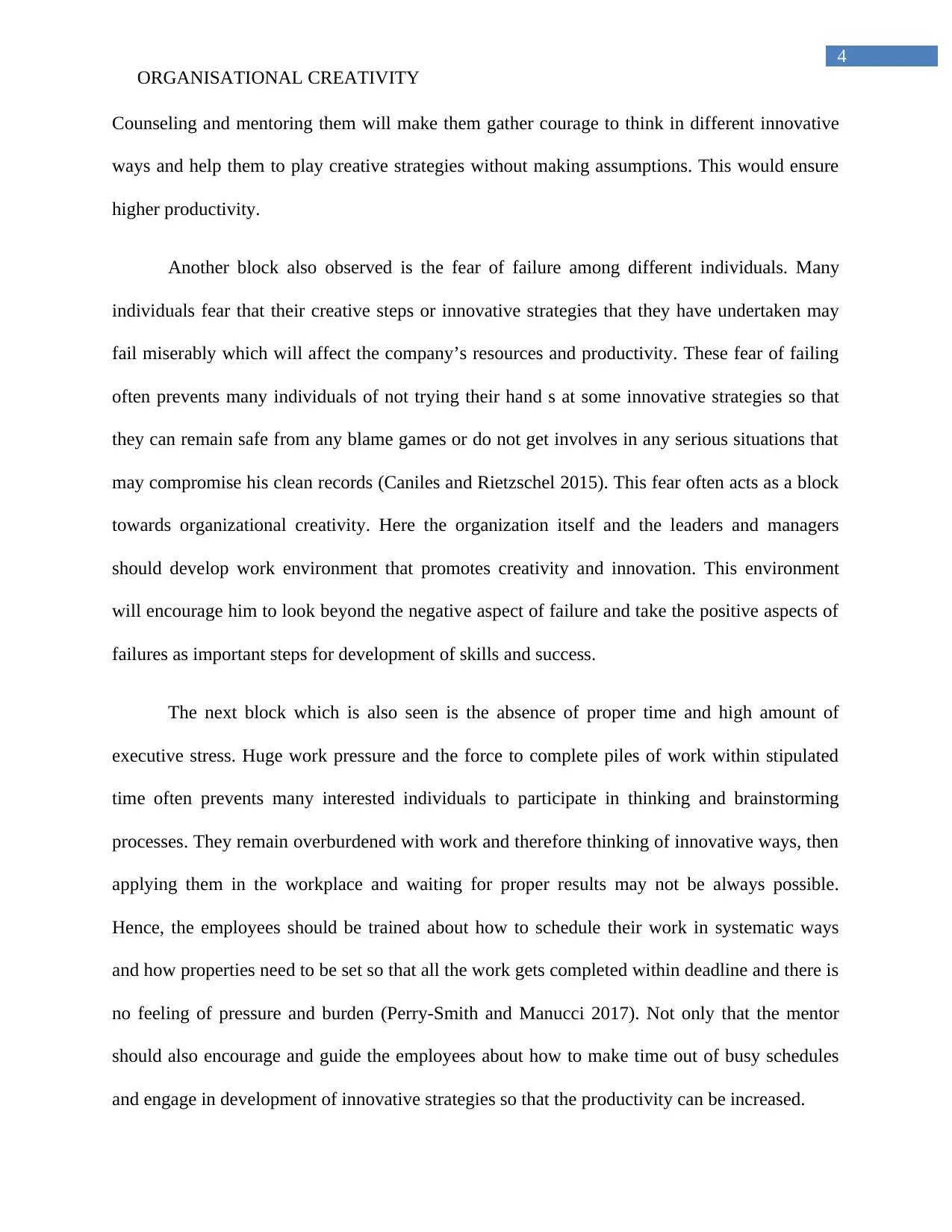
4
ORGANISATIONAL CREATIVITY
Counseling and mentoring them will make them gather courage to think in different innovative
ways and help them to play creative strategies without making assumptions. This would ensure
higher productivity.
Another block also observed is the fear of failure among different individuals. Many
individuals fear that their creative steps or innovative strategies that they have undertaken may
fail miserably which will affect the company’s resources and productivity. These fear of failing
often prevents many individuals of not trying their hand s at some innovative strategies so that
they can remain safe from any blame games or do not get involves in any serious situations that
may compromise his clean records (Caniles and Rietzschel 2015). This fear often acts as a block
towards organizational creativity. Here the organization itself and the leaders and managers
should develop work environment that promotes creativity and innovation. This environment
will encourage him to look beyond the negative aspect of failure and take the positive aspects of
failures as important steps for development of skills and success.
The next block which is also seen is the absence of proper time and high amount of
executive stress. Huge work pressure and the force to complete piles of work within stipulated
time often prevents many interested individuals to participate in thinking and brainstorming
processes. They remain overburdened with work and therefore thinking of innovative ways, then
applying them in the workplace and waiting for proper results may not be always possible.
Hence, the employees should be trained about how to schedule their work in systematic ways
and how properties need to be set so that all the work gets completed within deadline and there is
no feeling of pressure and burden (Perry-Smith and Manucci 2017). Not only that the mentor
should also encourage and guide the employees about how to make time out of busy schedules
and engage in development of innovative strategies so that the productivity can be increased.
ORGANISATIONAL CREATIVITY
Counseling and mentoring them will make them gather courage to think in different innovative
ways and help them to play creative strategies without making assumptions. This would ensure
higher productivity.
Another block also observed is the fear of failure among different individuals. Many
individuals fear that their creative steps or innovative strategies that they have undertaken may
fail miserably which will affect the company’s resources and productivity. These fear of failing
often prevents many individuals of not trying their hand s at some innovative strategies so that
they can remain safe from any blame games or do not get involves in any serious situations that
may compromise his clean records (Caniles and Rietzschel 2015). This fear often acts as a block
towards organizational creativity. Here the organization itself and the leaders and managers
should develop work environment that promotes creativity and innovation. This environment
will encourage him to look beyond the negative aspect of failure and take the positive aspects of
failures as important steps for development of skills and success.
The next block which is also seen is the absence of proper time and high amount of
executive stress. Huge work pressure and the force to complete piles of work within stipulated
time often prevents many interested individuals to participate in thinking and brainstorming
processes. They remain overburdened with work and therefore thinking of innovative ways, then
applying them in the workplace and waiting for proper results may not be always possible.
Hence, the employees should be trained about how to schedule their work in systematic ways
and how properties need to be set so that all the work gets completed within deadline and there is
no feeling of pressure and burden (Perry-Smith and Manucci 2017). Not only that the mentor
should also encourage and guide the employees about how to make time out of busy schedules
and engage in development of innovative strategies so that the productivity can be increased.
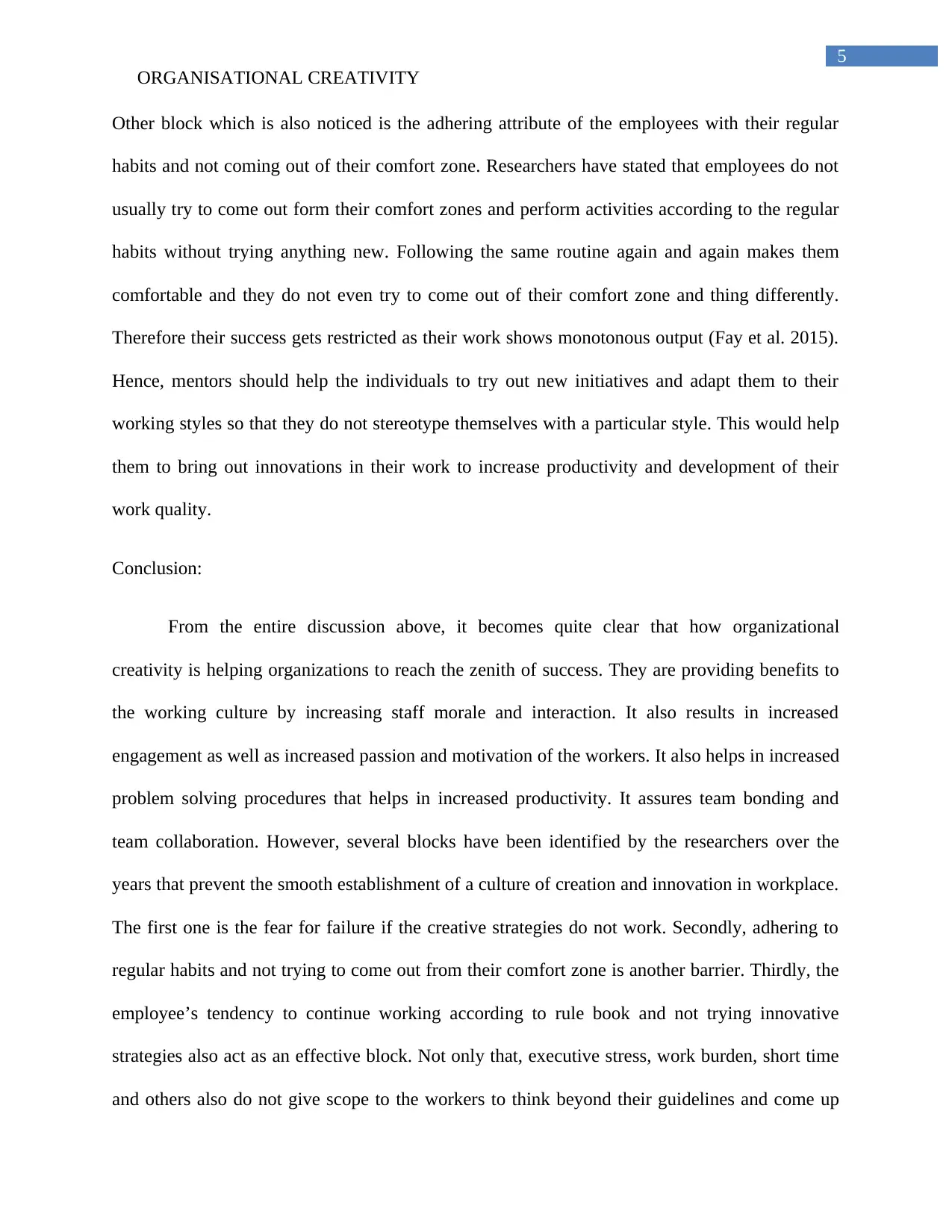
5
ORGANISATIONAL CREATIVITY
Other block which is also noticed is the adhering attribute of the employees with their regular
habits and not coming out of their comfort zone. Researchers have stated that employees do not
usually try to come out form their comfort zones and perform activities according to the regular
habits without trying anything new. Following the same routine again and again makes them
comfortable and they do not even try to come out of their comfort zone and thing differently.
Therefore their success gets restricted as their work shows monotonous output (Fay et al. 2015).
Hence, mentors should help the individuals to try out new initiatives and adapt them to their
working styles so that they do not stereotype themselves with a particular style. This would help
them to bring out innovations in their work to increase productivity and development of their
work quality.
Conclusion:
From the entire discussion above, it becomes quite clear that how organizational
creativity is helping organizations to reach the zenith of success. They are providing benefits to
the working culture by increasing staff morale and interaction. It also results in increased
engagement as well as increased passion and motivation of the workers. It also helps in increased
problem solving procedures that helps in increased productivity. It assures team bonding and
team collaboration. However, several blocks have been identified by the researchers over the
years that prevent the smooth establishment of a culture of creation and innovation in workplace.
The first one is the fear for failure if the creative strategies do not work. Secondly, adhering to
regular habits and not trying to come out from their comfort zone is another barrier. Thirdly, the
employee’s tendency to continue working according to rule book and not trying innovative
strategies also act as an effective block. Not only that, executive stress, work burden, short time
and others also do not give scope to the workers to think beyond their guidelines and come up
ORGANISATIONAL CREATIVITY
Other block which is also noticed is the adhering attribute of the employees with their regular
habits and not coming out of their comfort zone. Researchers have stated that employees do not
usually try to come out form their comfort zones and perform activities according to the regular
habits without trying anything new. Following the same routine again and again makes them
comfortable and they do not even try to come out of their comfort zone and thing differently.
Therefore their success gets restricted as their work shows monotonous output (Fay et al. 2015).
Hence, mentors should help the individuals to try out new initiatives and adapt them to their
working styles so that they do not stereotype themselves with a particular style. This would help
them to bring out innovations in their work to increase productivity and development of their
work quality.
Conclusion:
From the entire discussion above, it becomes quite clear that how organizational
creativity is helping organizations to reach the zenith of success. They are providing benefits to
the working culture by increasing staff morale and interaction. It also results in increased
engagement as well as increased passion and motivation of the workers. It also helps in increased
problem solving procedures that helps in increased productivity. It assures team bonding and
team collaboration. However, several blocks have been identified by the researchers over the
years that prevent the smooth establishment of a culture of creation and innovation in workplace.
The first one is the fear for failure if the creative strategies do not work. Secondly, adhering to
regular habits and not trying to come out from their comfort zone is another barrier. Thirdly, the
employee’s tendency to continue working according to rule book and not trying innovative
strategies also act as an effective block. Not only that, executive stress, work burden, short time
and others also do not give scope to the workers to think beyond their guidelines and come up
⊘ This is a preview!⊘
Do you want full access?
Subscribe today to unlock all pages.

Trusted by 1+ million students worldwide
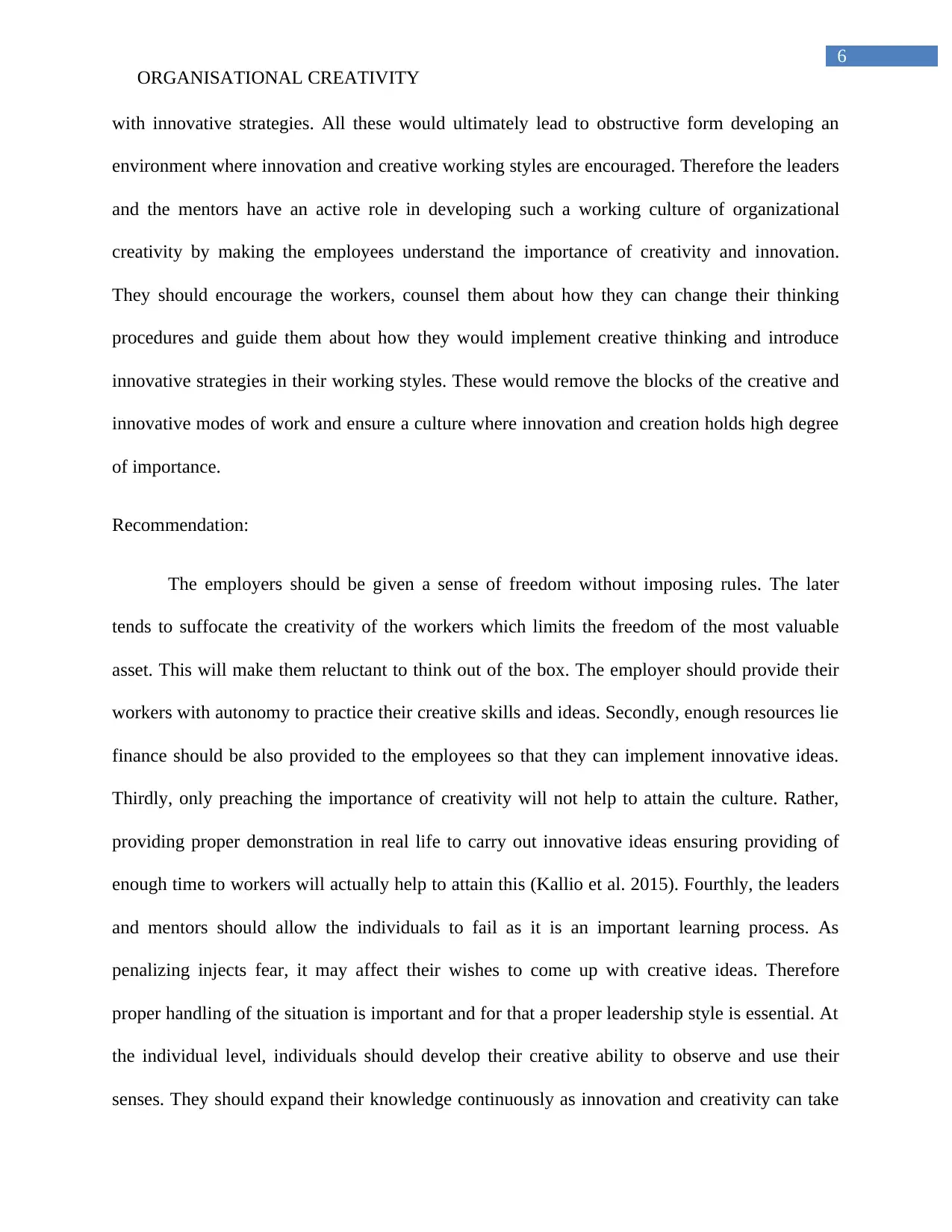
6
ORGANISATIONAL CREATIVITY
with innovative strategies. All these would ultimately lead to obstructive form developing an
environment where innovation and creative working styles are encouraged. Therefore the leaders
and the mentors have an active role in developing such a working culture of organizational
creativity by making the employees understand the importance of creativity and innovation.
They should encourage the workers, counsel them about how they can change their thinking
procedures and guide them about how they would implement creative thinking and introduce
innovative strategies in their working styles. These would remove the blocks of the creative and
innovative modes of work and ensure a culture where innovation and creation holds high degree
of importance.
Recommendation:
The employers should be given a sense of freedom without imposing rules. The later
tends to suffocate the creativity of the workers which limits the freedom of the most valuable
asset. This will make them reluctant to think out of the box. The employer should provide their
workers with autonomy to practice their creative skills and ideas. Secondly, enough resources lie
finance should be also provided to the employees so that they can implement innovative ideas.
Thirdly, only preaching the importance of creativity will not help to attain the culture. Rather,
providing proper demonstration in real life to carry out innovative ideas ensuring providing of
enough time to workers will actually help to attain this (Kallio et al. 2015). Fourthly, the leaders
and mentors should allow the individuals to fail as it is an important learning process. As
penalizing injects fear, it may affect their wishes to come up with creative ideas. Therefore
proper handling of the situation is important and for that a proper leadership style is essential. At
the individual level, individuals should develop their creative ability to observe and use their
senses. They should expand their knowledge continuously as innovation and creativity can take
ORGANISATIONAL CREATIVITY
with innovative strategies. All these would ultimately lead to obstructive form developing an
environment where innovation and creative working styles are encouraged. Therefore the leaders
and the mentors have an active role in developing such a working culture of organizational
creativity by making the employees understand the importance of creativity and innovation.
They should encourage the workers, counsel them about how they can change their thinking
procedures and guide them about how they would implement creative thinking and introduce
innovative strategies in their working styles. These would remove the blocks of the creative and
innovative modes of work and ensure a culture where innovation and creation holds high degree
of importance.
Recommendation:
The employers should be given a sense of freedom without imposing rules. The later
tends to suffocate the creativity of the workers which limits the freedom of the most valuable
asset. This will make them reluctant to think out of the box. The employer should provide their
workers with autonomy to practice their creative skills and ideas. Secondly, enough resources lie
finance should be also provided to the employees so that they can implement innovative ideas.
Thirdly, only preaching the importance of creativity will not help to attain the culture. Rather,
providing proper demonstration in real life to carry out innovative ideas ensuring providing of
enough time to workers will actually help to attain this (Kallio et al. 2015). Fourthly, the leaders
and mentors should allow the individuals to fail as it is an important learning process. As
penalizing injects fear, it may affect their wishes to come up with creative ideas. Therefore
proper handling of the situation is important and for that a proper leadership style is essential. At
the individual level, individuals should develop their creative ability to observe and use their
senses. They should expand their knowledge continuously as innovation and creativity can take
Paraphrase This Document
Need a fresh take? Get an instant paraphrase of this document with our AI Paraphraser
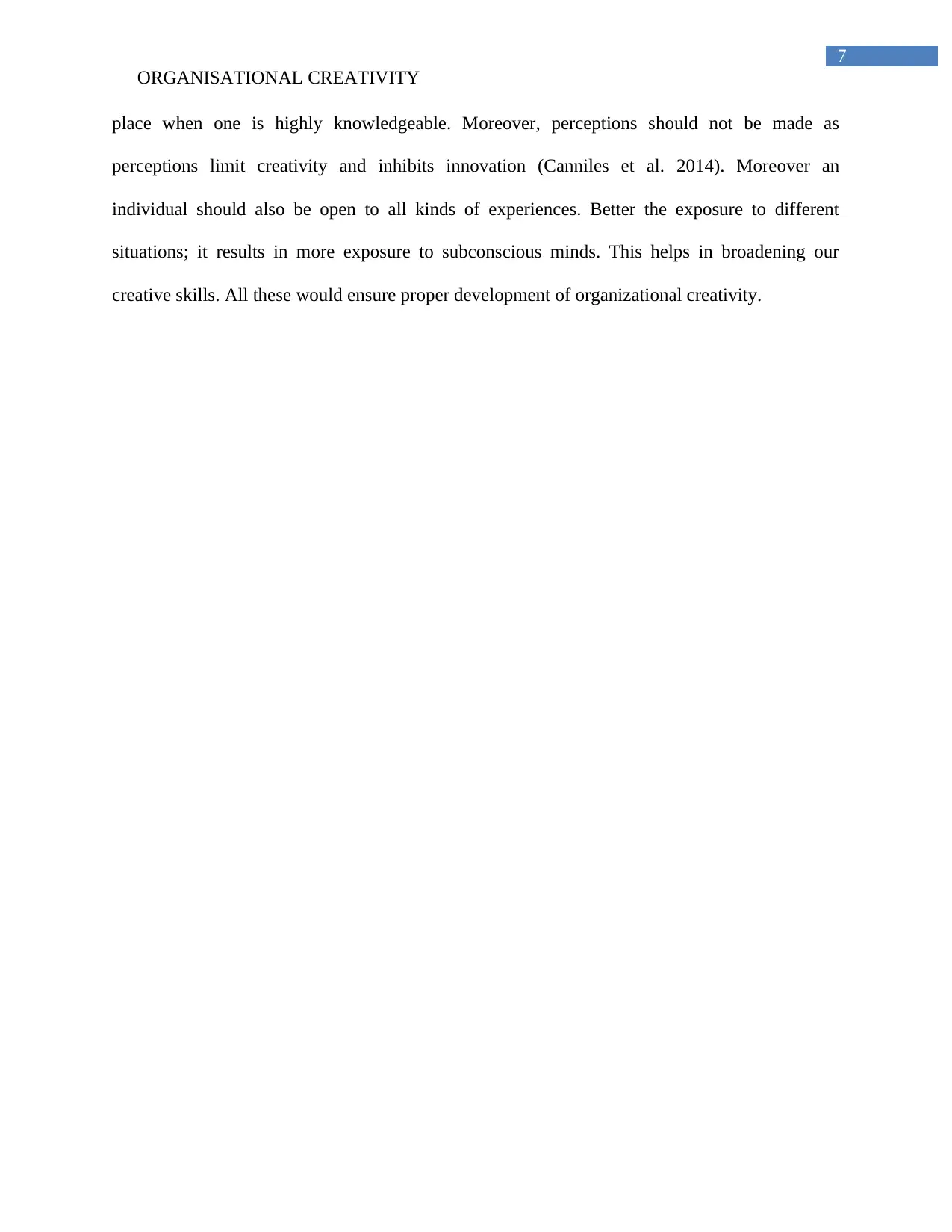
7
ORGANISATIONAL CREATIVITY
place when one is highly knowledgeable. Moreover, perceptions should not be made as
perceptions limit creativity and inhibits innovation (Canniles et al. 2014). Moreover an
individual should also be open to all kinds of experiences. Better the exposure to different
situations; it results in more exposure to subconscious minds. This helps in broadening our
creative skills. All these would ensure proper development of organizational creativity.
ORGANISATIONAL CREATIVITY
place when one is highly knowledgeable. Moreover, perceptions should not be made as
perceptions limit creativity and inhibits innovation (Canniles et al. 2014). Moreover an
individual should also be open to all kinds of experiences. Better the exposure to different
situations; it results in more exposure to subconscious minds. This helps in broadening our
creative skills. All these would ensure proper development of organizational creativity.
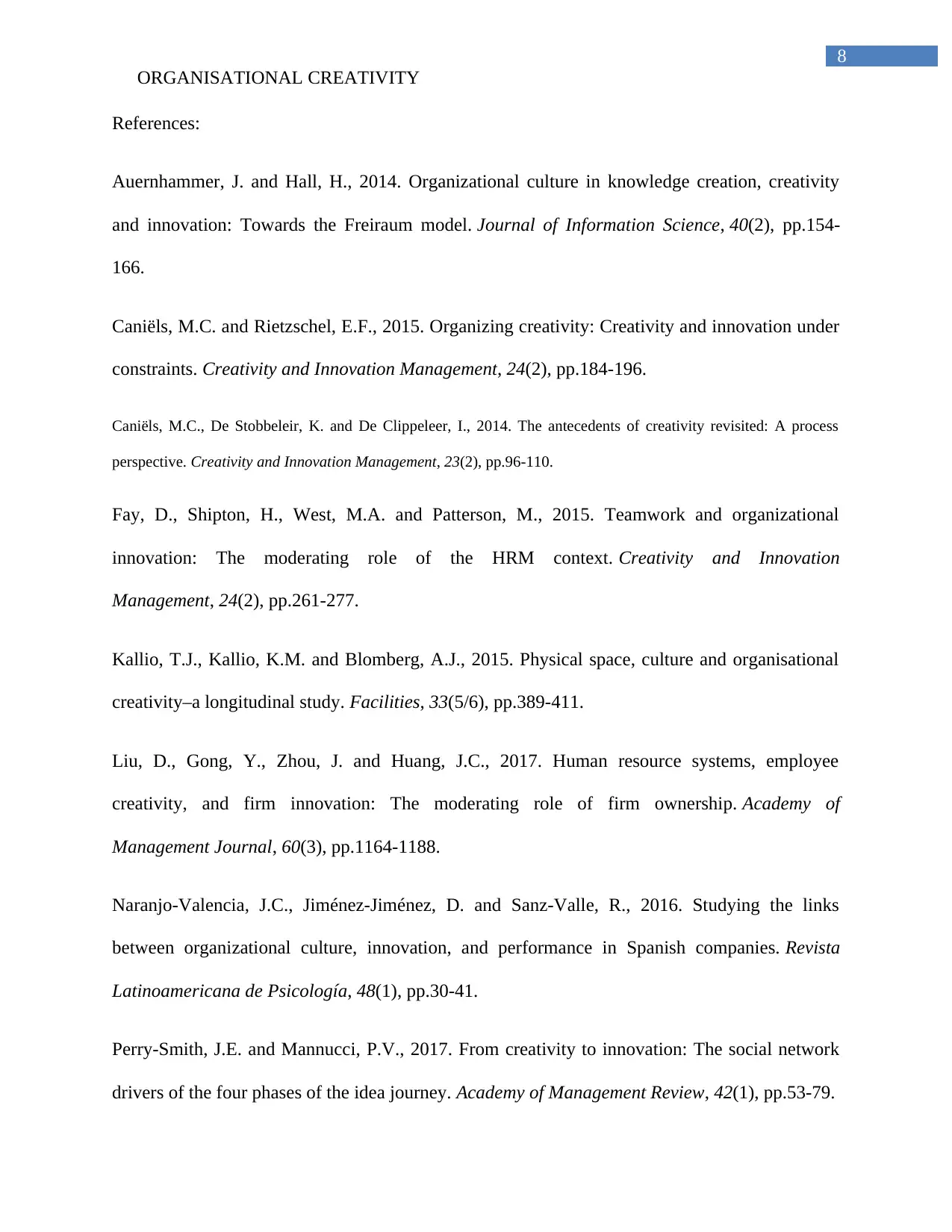
8
ORGANISATIONAL CREATIVITY
References:
Auernhammer, J. and Hall, H., 2014. Organizational culture in knowledge creation, creativity
and innovation: Towards the Freiraum model. Journal of Information Science, 40(2), pp.154-
166.
Caniëls, M.C. and Rietzschel, E.F., 2015. Organizing creativity: Creativity and innovation under
constraints. Creativity and Innovation Management, 24(2), pp.184-196.
Caniëls, M.C., De Stobbeleir, K. and De Clippeleer, I., 2014. The antecedents of creativity revisited: A process
perspective. Creativity and Innovation Management, 23(2), pp.96-110.
Fay, D., Shipton, H., West, M.A. and Patterson, M., 2015. Teamwork and organizational
innovation: The moderating role of the HRM context. Creativity and Innovation
Management, 24(2), pp.261-277.
Kallio, T.J., Kallio, K.M. and Blomberg, A.J., 2015. Physical space, culture and organisational
creativity–a longitudinal study. Facilities, 33(5/6), pp.389-411.
Liu, D., Gong, Y., Zhou, J. and Huang, J.C., 2017. Human resource systems, employee
creativity, and firm innovation: The moderating role of firm ownership. Academy of
Management Journal, 60(3), pp.1164-1188.
Naranjo-Valencia, J.C., Jiménez-Jiménez, D. and Sanz-Valle, R., 2016. Studying the links
between organizational culture, innovation, and performance in Spanish companies. Revista
Latinoamericana de Psicología, 48(1), pp.30-41.
Perry-Smith, J.E. and Mannucci, P.V., 2017. From creativity to innovation: The social network
drivers of the four phases of the idea journey. Academy of Management Review, 42(1), pp.53-79.
ORGANISATIONAL CREATIVITY
References:
Auernhammer, J. and Hall, H., 2014. Organizational culture in knowledge creation, creativity
and innovation: Towards the Freiraum model. Journal of Information Science, 40(2), pp.154-
166.
Caniëls, M.C. and Rietzschel, E.F., 2015. Organizing creativity: Creativity and innovation under
constraints. Creativity and Innovation Management, 24(2), pp.184-196.
Caniëls, M.C., De Stobbeleir, K. and De Clippeleer, I., 2014. The antecedents of creativity revisited: A process
perspective. Creativity and Innovation Management, 23(2), pp.96-110.
Fay, D., Shipton, H., West, M.A. and Patterson, M., 2015. Teamwork and organizational
innovation: The moderating role of the HRM context. Creativity and Innovation
Management, 24(2), pp.261-277.
Kallio, T.J., Kallio, K.M. and Blomberg, A.J., 2015. Physical space, culture and organisational
creativity–a longitudinal study. Facilities, 33(5/6), pp.389-411.
Liu, D., Gong, Y., Zhou, J. and Huang, J.C., 2017. Human resource systems, employee
creativity, and firm innovation: The moderating role of firm ownership. Academy of
Management Journal, 60(3), pp.1164-1188.
Naranjo-Valencia, J.C., Jiménez-Jiménez, D. and Sanz-Valle, R., 2016. Studying the links
between organizational culture, innovation, and performance in Spanish companies. Revista
Latinoamericana de Psicología, 48(1), pp.30-41.
Perry-Smith, J.E. and Mannucci, P.V., 2017. From creativity to innovation: The social network
drivers of the four phases of the idea journey. Academy of Management Review, 42(1), pp.53-79.
⊘ This is a preview!⊘
Do you want full access?
Subscribe today to unlock all pages.

Trusted by 1+ million students worldwide
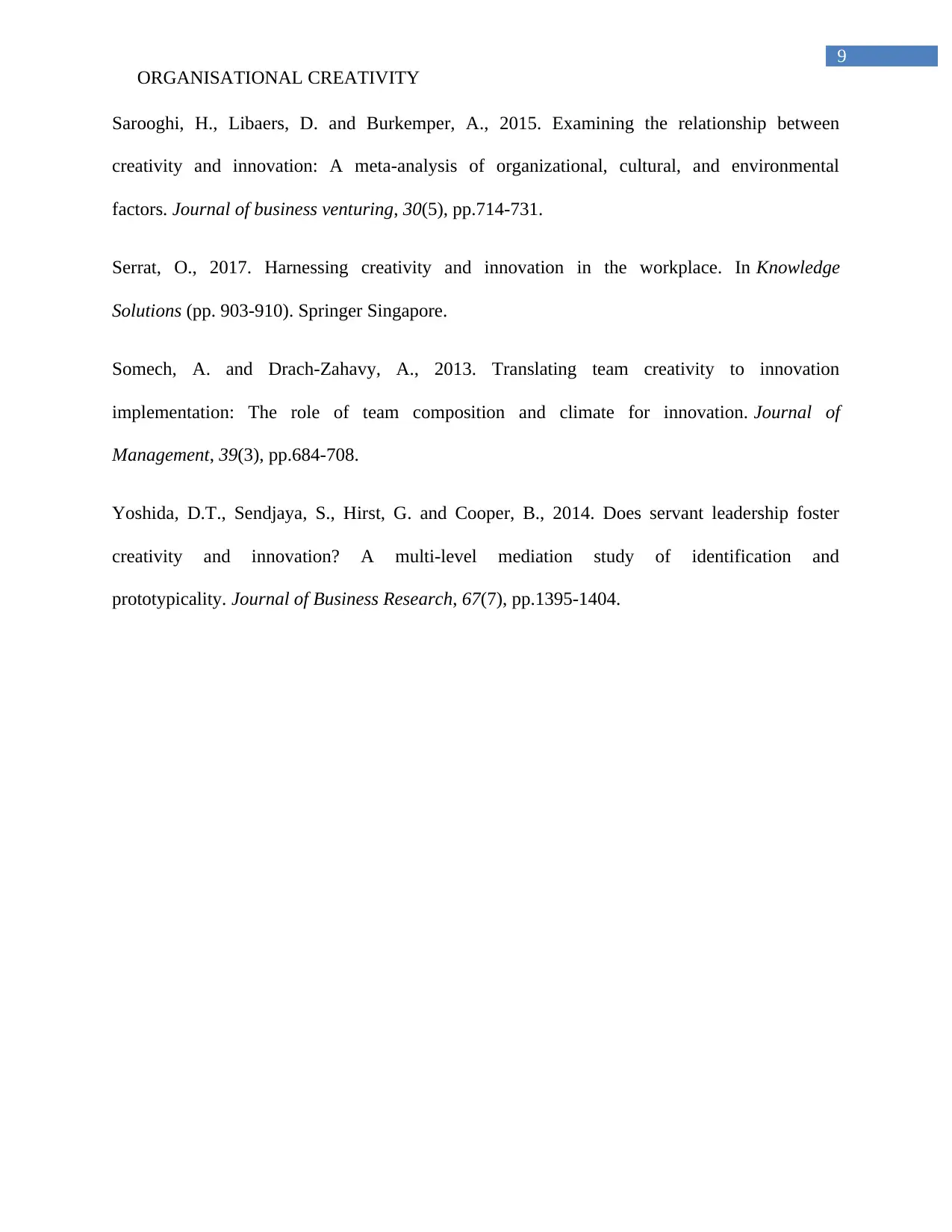
9
ORGANISATIONAL CREATIVITY
Sarooghi, H., Libaers, D. and Burkemper, A., 2015. Examining the relationship between
creativity and innovation: A meta-analysis of organizational, cultural, and environmental
factors. Journal of business venturing, 30(5), pp.714-731.
Serrat, O., 2017. Harnessing creativity and innovation in the workplace. In Knowledge
Solutions (pp. 903-910). Springer Singapore.
Somech, A. and Drach-Zahavy, A., 2013. Translating team creativity to innovation
implementation: The role of team composition and climate for innovation. Journal of
Management, 39(3), pp.684-708.
Yoshida, D.T., Sendjaya, S., Hirst, G. and Cooper, B., 2014. Does servant leadership foster
creativity and innovation? A multi-level mediation study of identification and
prototypicality. Journal of Business Research, 67(7), pp.1395-1404.
ORGANISATIONAL CREATIVITY
Sarooghi, H., Libaers, D. and Burkemper, A., 2015. Examining the relationship between
creativity and innovation: A meta-analysis of organizational, cultural, and environmental
factors. Journal of business venturing, 30(5), pp.714-731.
Serrat, O., 2017. Harnessing creativity and innovation in the workplace. In Knowledge
Solutions (pp. 903-910). Springer Singapore.
Somech, A. and Drach-Zahavy, A., 2013. Translating team creativity to innovation
implementation: The role of team composition and climate for innovation. Journal of
Management, 39(3), pp.684-708.
Yoshida, D.T., Sendjaya, S., Hirst, G. and Cooper, B., 2014. Does servant leadership foster
creativity and innovation? A multi-level mediation study of identification and
prototypicality. Journal of Business Research, 67(7), pp.1395-1404.
1 out of 10
Related Documents
Your All-in-One AI-Powered Toolkit for Academic Success.
+13062052269
info@desklib.com
Available 24*7 on WhatsApp / Email
![[object Object]](/_next/static/media/star-bottom.7253800d.svg)
Unlock your academic potential
Copyright © 2020–2025 A2Z Services. All Rights Reserved. Developed and managed by ZUCOL.





